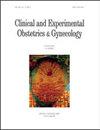妊娠期吸食尼古丁:对妇产科医生关于电子尼古丁输送系统的安全性和使用知识的地理评估
IF 0.6
4区 医学
Q4 OBSTETRICS & GYNECOLOGY
引用次数: 0
摘要
背景:电子尼古丁输送系统(ENDS)或电子烟的使用越来越流行,公众普遍对其持积极态度。然而,已知ENDS含有有害化学物质和致畸物,会对孕妇和胎儿造成许多健康后果。尽管如此,医生的知识和讨论与他们的孕妇结局仍然有限。本研究的主要目的是评估妇产科(OBGYN)提供者对妊娠期ENDS的安全性和使用的了解。第二个目标是了解提供者的做法,以提高患者对ENDS对孕妇和发育中的胎儿的影响的教育和认识。方法:本研究采用40个问题的在线匿名调查。该调查旨在评估妇产科医生对终端使用和潜在危害的理解。调查表已分发给美利坚合众国中西部和南部的妇产科医生。结果:共104人完成调查,回复率95%。虽然96%的提供者在产前检查时调查了酒精和烟草的使用情况,但只有44%的人定期询问终端的使用情况。大多数供应商指出,他们没有接受过关于电子烟使用的正式教育,55%的供应商表示对电子烟的了解不足。结论:这些结果表明,提供者缺乏对妊娠期终末药物使用的教育和知识。这是令人担忧的,因为终端的使用在美利坚合众国正在迅速增加。为供应商开发有关电子烟风险的教育资源,并将电子烟的使用问题纳入社会历史,特别是在怀孕期间,这一点至关重要。本文章由计算机程序翻译,如有差异,请以英文原文为准。
Vaping in pregnancy: a geographically focused assessment of OBGYN provider knowledge regarding the safety and usage of electronic nicotine delivery systems
Background: Electronic nicotine delivery systems (ENDS), or vaping, usage has become increasingly popular and generally has a positive perception by the public. However, ENDS are known to contain harmful chemicals and teratogens that induce numerous health consequences to both the pregnant mother and fetus. Despite this, physician knowledge and discussion of ENDS with their pregnant patients remains limited. Themain objective of this study was to assess the knowledge of Obstetrics and Gynecology (OBGYN) providers regarding the safety and usage of ENDS in pregnancy. A secondary objective was to understand providers’ practices to increase patient education and awareness of the effects of ENDS on pregnant women and developing fetuses. Methods: A 40-question online anonymous survey was developed for this study. The survey aimed at assessing OBGYN providers’ understanding of the usage of ENDS and potential harms. The questionnaire was distributed to OBGYN providers in the Midwest and South of the United States of America. Results: One Hundred and four respondents completed the survey (95% response rate). While 96% of providers investigated alcohol and tobacco use during prenatal visits, only 44% routinely inquired about ENDS use. Most providers noted that they had received no formal education about ENDS usage and 55% of providers reported an insufficient understanding of vaping. Conclusions: These results demonstrate that providers lack the education and knowledge about ENDS usage in pregnancy. This is concerning as ENDS usage is rapidly increasing in the United States of America. It is essential to develop educational resources for providers about the risks of vaping and incorporate questions ENDS usage into the social history, especially in pregnancy.
求助全文
通过发布文献求助,成功后即可免费获取论文全文。
去求助
来源期刊
CiteScore
0.50
自引率
0.00%
发文量
241
审稿时长
1 months
期刊介绍:
CEOG is an international, peer-reviewed, open access journal. CEOG covers all aspects of Obstetrics and Gynecology, including obstetrics, prenatal diagnosis, maternal-fetal medicine, perinatology, general gynecology, gynecologic oncology, uro-gynecology, reproductive medicine, infertility, reproductive endocrinology, sexual medicine. All submissions of cutting-edge advances of medical research in the area of women''s health worldwide are encouraged.

 求助内容:
求助内容: 应助结果提醒方式:
应助结果提醒方式:


